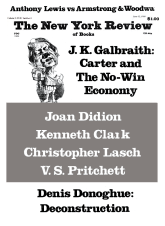In response to:
The Emperor of Roman History from the March 6, 1980 issue
To the Editors:
Mr. Bowersock’s discussion [NYR, March 6] of the Symean revolution in scholarship is admirable but the latter’s restorative (to Gibbon and Tacitus) revolution might be evaluated less one-sidedly if Mr. Bowersock utilized a less one-sided view of revolution. He argues with Syme that the Augustan civil war stood not for a real revolution against the established order but rather a revolution in the name of restoration. “No revolutionary in America, France, or Russia,” he states, “saw the re-establishment of the old order as his official objective.” True. Not the old order concretely. But a return to ancient virtues has been a recurrent revolutionary theme. James Wilson and a number of other legalists developed an explicit theory of a loyalist revolution in the name of the restoration of the constitutional principles of the first British empire. as expressed in the Case of the Postnati (1608). Charles H. Mcllwain wrote The American Revolution in an effort (much contested) to prove that the Revolution was in fact “constitutional” and restorative. The basic structure of federalism in the 1789 Constitution was in effect a restorative and republicanized version of the early seventeenth-century imperial constitution.
The American revolutionaries were not the inventors of the idea of restorative revolution, however. Locke’s theory of revolution was overtly restorative of allegedly immemorial natural laws that thinly cloaked certain constitutional principles earlier hypostatized against the Stuarts by proto-Whig legal anti-quarians like Coke and Selden.
Whig historicism implies a restorative theory of revolution, which helps account for its stubborn persistence. That it translates well from English into Russian is revealed in E.H. Carr’s masterwork. Doubtless it can also be Latinized into a reconciliation of Mommsen and Syme.
Harvey Wheeler
Carpinteria, California
G.W Bowersock replies:
It is helpful to be reminded of the recurrence of a return to ancient virtues as a revolutionary theme. In fact, this played an important role in the Augustan revolution, which emphasized the resuscitation of priesthoods from the distant past and the encouragement of old-fashioned morals. But I think it is imperative to separate rather than to reconcile the themes of ancient virtue and the status quo ante. From the constitutional point of view Augustus’s res publica restituta was the republic in existence before the disturbances of the civil war. He wanted to persuade the Romans that the time of troubles was over and that the republic which they all could remember was back again. This is quite different from claiming to restore some superior system from the more distant past. Tacitus rightly suggested that it was not until those who remembered the republic had died off that the Augustan fraud was fully entrenched: by the last years of Augustus “the younger citizens had been born after the victory at Actium, most of the older ones during the civil wars—how many were left who had seen the republic?”
This Issue
June 12, 1980



